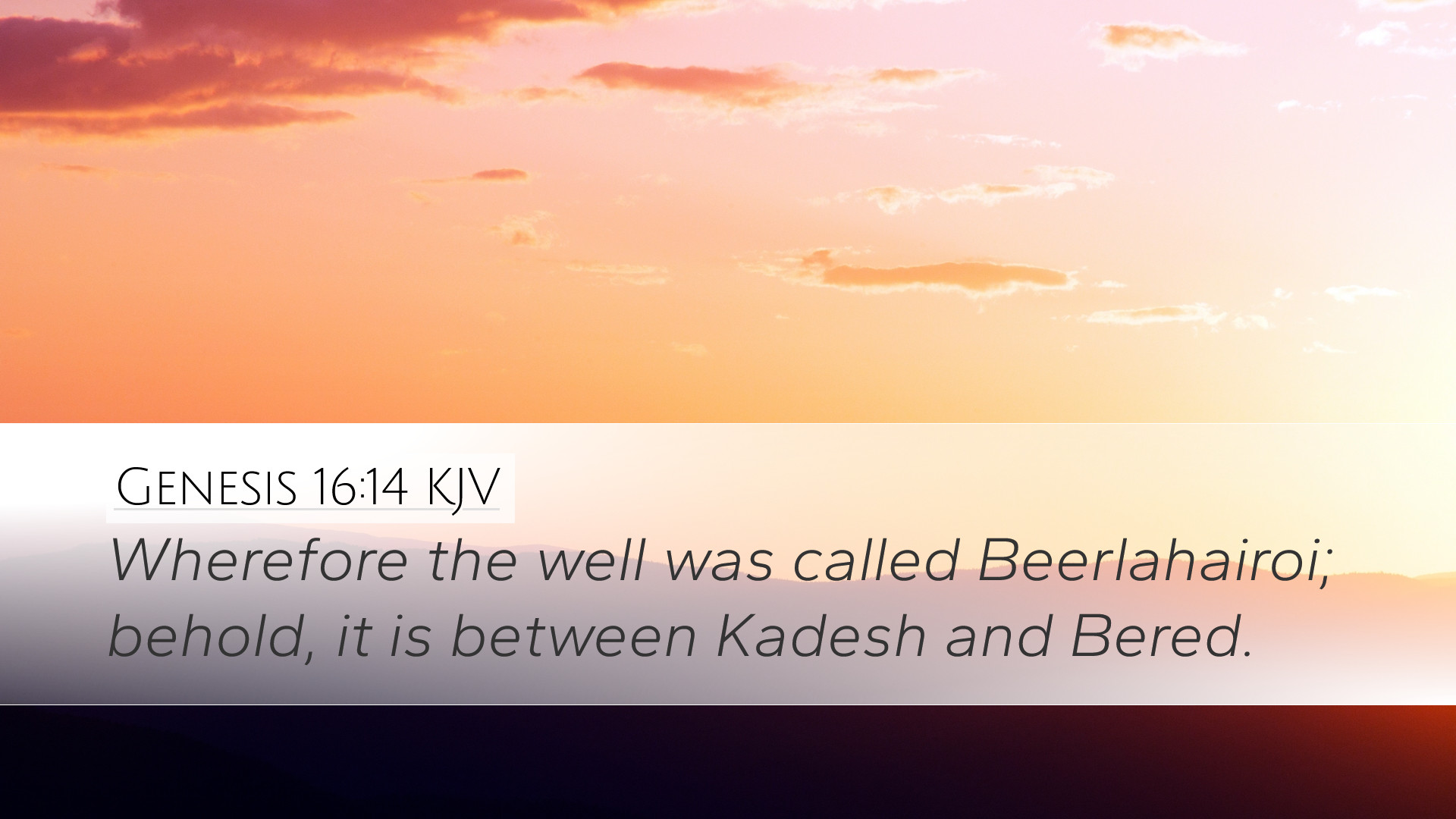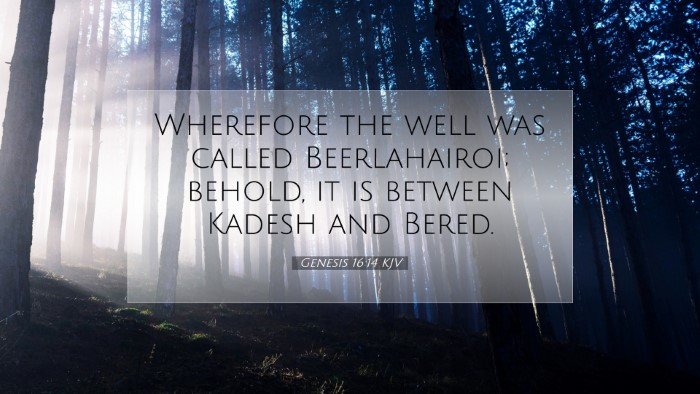Commentary on Genesis 16:14
Genesis 16:14 states: "Therefore the well was called Beer-lahai-roi; behold, it is between Kadesh and Bered." This verse concludes the account of Hagar, illustrating the significance of divine providence in the midst of human struggles. Various commentators shed light on its meaning, application, and theological implications.
Understanding Beer-lahai-roi
This name, Beer-lahai-roi, translates to "the well of the Living One who sees me." It reflects Hagar's profound experience of God’s presence and care during her trial. The well serves as a literal and symbolic source of sustenance in her life, emphasizing the grace of God in her moment of distress.
Interpretation from Matthew Henry
Matthew Henry, in his commentary, highlights the significance of this well as a reminder of God’s attentiveness. Hagar, a marginalized figure within the narrative, encounters the divine when she feels most abandoned. Henry emphasizes that this reflects God's impartiality, affirming His love and concern not only for the chosen people but also for the outsiders.
Insights from Albert Barnes
Albert Barnes points out that the well’s naming is indicative of the geographical and spiritual significance. The term “Beer” is commonly translated as “well,” while “lahai-roi” emphasizes the life-giving aspect of the One who sees. Barnes expands on the idea that the naming of places often denotes a divine encounter, thus reinforcing the theology of God's providence. He suggests that this moment signifies a shift in Hagar’s understanding of God—from a distant deity to a personal guardian who observes and cares for her plight.
Reflections from Adam Clarke
Adam Clarke elaborates by examining the geographical context. He remarks that the well’s location between Kadesh and Bered is indicative of a barren wilderness, symbolizing the struggles that often accompany God’s calling. Clarke asserts that Hagar’s encounter represents a turning point—she moves from despair to hope through an understanding of God’s watchful presence. His commentary encourages readers to recognize that even in desolation, God provides refreshment and sustenance, echoing the Christian understanding of spiritual sustenance through faith in God’s promises.
Theological Implications
This verse not only recounts a historical event but also invites reflection on God's character and His relationship with humanity.
- Divine Awareness: The phrase "the Living One who sees me" encapsulates the essence of a God who is intimately involved in the lives of His creation.
- Inclusivity of God’s Grace: Hagar’s story illustrates that divine favor is not limited to the socio-religious elite. It serves as a strong reminder that God sees all, including the marginalized and the vulnerable.
- Transformation Through Encounter: Hagar’s encounter with God transforms her perspective on her circumstances. She acknowledges both her plight and God’s provision, leading to new life and purpose.
Practical Applications
This verse speaks powerfully to today’s believers, especially in contexts where feelings of abandonment and isolation are prevalent.
- Encouragement in Trials: Just as Hagar found renewed strength at the well, believers are reminded that God sees their struggles and offers comfort and support in times of need.
- Recognizing God’s Presence: Followers of Christ are encouraged to be attuned to God’s leading and to recognize His provisions in both abundance and austerity.
- Advocacy for the Marginalized: Hagar's story prompts believers to extend compassion towards those who may feel alienated or oppressed, reflecting God’s heart for all people.
Conclusion
Genesis 16:14 encapsulates a pivotal moment in the narrative of Hagar, demonstrating that God sees, cares, and provides even in the wildernesses of life. Through the insights of notable public domain commentators, we glean a rich understanding of the text that emphasizes God's inclusive grace, presence in trials, and the transformation that comes from divine encounters. For pastors, students, theologians, and Bible scholars, this passage inspires a deeper inquiry into the nature of God’s covenantal relationship with all humanity, affirming that no one is beyond His sight.


